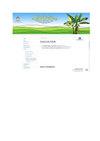Residual effects of phosphorus sources in grain Amaranth Amaranthus cruentus L production 98
IF 0.2
Q4 AGRONOMY
引用次数: 0
Abstract
Productivity of grain amaranth can be improved at reduced cost through combined use of low-cost Rock Phosphate (RP) phosphorus sources as well as selection of amaranth varieties with high phosphorus (P) use efficiencies. RP sources are known to exhibit differences with respect to grain yield, disease tolerance and P use efficiency (PUE) in amaranth varieties. However, very little is known about their residual release of P. It is probable that the differential performances exhibited by the RPs might be a function of their P residual properties after cropping. Based on these premises this study was carried out to evaluate the residual effects of P sources under continuous croppings for grain amaranth production. The study was a factorial experiment with four replications. Four P sources: Single Super Phosphate – SSP, Ogun Rock Phosphate – ORP, Sokoto Rock Phosphate – SRP and control; three amaranth varieties: NH84/493, NH84/445 and NH84/452 were factorially combined with two soil types: Kaudiudult and Haplustalf. In order to monitor the residual effects of the P sources the experimental plots were cropped consecutively three times. Results from the study revealed that in the sandy loam Haplustalf, grain amaranth yield was better than that in the clayey Kaudiudult soil under a continuous cropping system. Grain yield and Relative Agronomic Efficiency (RAE) decreased with continuous cropping for SSP but increased with continuous cropping for ORP and SRP till second cropping; thereafter there was a decrease. Averaged over the three continuous consecutive croppings, SRP and ORP were 68.9% and 73.5% as effective as SSP in increasing grain yield respectively. It was concluded therefore that ORP and Haplustalf soil are best options for grain amaranth production under continuous cropping system.磷源对籽粒苋菜生产的残留效应[j]
通过低成本磷矿磷源的联合利用和磷利用效率高的苋菜品种的选择,可以以较低的成本提高籽粒苋菜的产量。已知RP源在苋菜品种的籽粒产量、抗病性和P利用效率(PUE)方面存在差异。然而,我们对它们的磷残留量知之甚少,很可能这些rp表现出的差异可能是它们在种植后磷残留量的函数。在此前提下,本研究对连续种植条件下不同磷源的残留效应进行了评价。这项研究是一个四次重复的析因实验。四种磷源:Single Super Phosphate - SSP、Ogun Rock Phosphate - ORP、Sokoto Rock Phosphate - SRP和control;3个苋菜品种NH84/493、NH84/445和NH84/452与两种土壤类型(Kaudiudult和Haplustalf)因子组合。为监测磷源的残留效应,试验田连续三次刈割。结果表明,在砂质壤土中,连作条件下粒苋菜产量优于粘质土。籽粒产量和相对农艺效率(RAE)随SSP连作而降低,ORP和SRP连作至二茬而增加;此后有所减少。3次连作中,SRP和ORP的增产效果分别为SSP的68.9%和73.5%。因此,在连作制度下,ORP和单株土壤是生产苋菜的最佳选择。
本文章由计算机程序翻译,如有差异,请以英文原文为准。
求助全文
约1分钟内获得全文
求助全文
来源期刊

Tropical Agriculture
Social Sciences-Development
CiteScore
0.50
自引率
0.00%
发文量
0
期刊介绍:
The overarching aim of Tropical Agriculture is to contribute to the process of agricultural development in tropical agro-ecosystems, through publication of papers in the area of agricultural science and technology. The specific objectives of the Journal are: -To address the practical aspects of sustainable tropical agriculture production, improvement, protection and commodity utilization, worldwide. -To foster the application of science and technology to understanding and removal of constraints to tropical agricultural productivity. -To publish the results of original research which make significant contributions to knowledge on the practice of sustainable and productive tropical agriculture. The Journal publishes papers in the following areas of tropical agriculture: -Soil Science and Technology -Environmental Science and Technology -Crop Science and Technology -Livestock Science and Technology as well as: Food and Nutrition Policy, Post-Harvest Technology, Agricultural Economics and Extension, Agribusiness
 求助内容:
求助内容: 应助结果提醒方式:
应助结果提醒方式:


